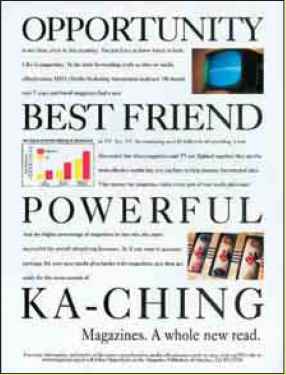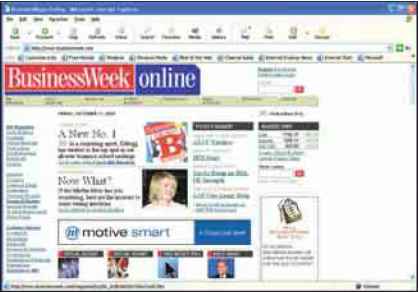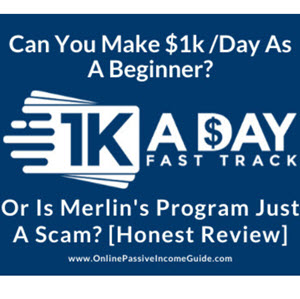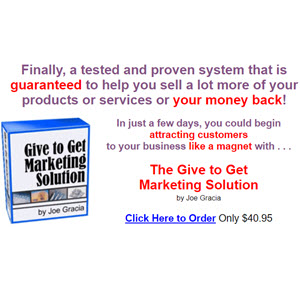Proving That Magazine Ads Work
For years magazine publishers focused most of their attention on selling ads in their magazines and devoted less attention to proving the ads were effective. At many magazines, efforts at measuring effectiveness were often limited to tracking consumer response to 800 numbers that appeared in print ads. However,the carefree days are over as many new advertising media have emerged, such as niche-oriented cable TV networks, narrowly targeted radio stations, and the Internet. Moreover, there are more than twice as many magazines competing for media dollars as there were a decade ago. With so many media options available, marketers now want tangible proof that magazine advertising is effective and can build brand awareness, help position a brand,or actually deliver sales.
Magazines have typically promised advertisers exposure or access to a well-defined audience such as fashion-conscious young women, sports-obsessed men, or automotive buffs. However, advertisers want evidence of more than exposure. They want proof that seeing an ad for Calvin Klein jeans in Cosmo makes readers more likely to spend $80 to buy them or that placing an ad for a Volkswagen Jetta in Rolling Stone helps the brand stick in consumers' minds long enough to influence their next auto purchase. The executive vice president of Conde Naste Publications, Inc., which publishes popular titles such as Vogue, GQ, Glamour, and Vanity Fair, says: "Twenty years ago, our only obligation to advertisers was to gather people who would see the ad. Now we must prove the ad actually does something. Sometimes, that's possible; sometimes it's not."
Magazines increasingly have to compete against media that can provide evidence that their ads do indeed do something. For example, the Internet can show accountability instantly because consumers' movements and purchases can be tracked through their mouse clicks. And with new digital technology, television sets will soon become transactional tools, allowing consumers to order information and goods right from their sofas with a remote control. Magazines can ill afford to wait any longer to prove that they work.
The magazine industry is taking steps to address the accountability issue. The industry's lead trade group, Magazine Publishers of America (MPA), recently spent half a million dollars investigating ways to prove magazine effectiveness. One of the group's studies found that boosting ad spending in magazines increased short-term sales of products and also generated more sales over time. Sales increased among magazine-exposed households for 8 of the 10 brands measured. Individual magazines are also trying to prove how advertising in their pages can help build a brand or move the sales needle. Another phase of the study found a significant relationship between advertising awareness and purchase intention. Moreover, awareness attributed to a combination of both television and magazines was most strongly related to positive changes in purchase intention. This "media multiplier" effect occurs because the heavy magazine reader is traditionally a light TV viewer and magazines deliver a new audience when added to a heavy TV schedule and can also help build frequency.
Consumers' loyalty to magazines and their willingness to spend uninterrupted, focused time with them has always been a powerful selling point for the medium. Now, however, magazines must prove that their connection with readers will generate sales for the companies that advertise in them. As Chris Miller, the MPA's head of marketing, notes: "One of the most important questions for this industry is the bottomline question—does it drive sales?"
Source: Wendy Bounds,"Magazines Seek to Demonstrate Efficacy of Ads," The Wall Street Journal, Apr. 12,1999, pp. Bl,3. Magazine Publishers of America,"Documenting the Effectiveness of Magazines in the Media Mix," www.magazine.org.

the prices consumers pay for subscriptions. In 1990 the average magazine subscription rate was $26.90. In 2001 it was $25.30. Thus, publishers have to pay more to maintain their rate bases (the circulation level guaranteed to advertisers), but they make less money on each subscription sold.
Publishers are also facing a drop in sweepstakes-generated circulation as a result of the controversy that developed over consumer confidence in the sweepstakes-related subscription offers. Agents such as Publishers Clearing House and American Family Enterprises have been going through changes, both self-imposed and externally dictated, that have greatly reduced the number of subscriptions they generate for publish-ers.23 To compensate for losses from sweepstakes agents, publishers are looking to other methods of generating subscribers, such as making subscriptions available through websites, offering free trial copies online, conducting special promotions, or using other agents such as school-related subscription services.24
Many magazines are also focusing more attention on managing their circulation bases. For many years, magazines focused on increasing their circulation under the assumption that higher circulation meant higher advertising rates. However, publishers are now realizing that the cost of attracting and maintaining the last 10 to 15 percent of their circulation base is often greater than the additional revenue generated, since these subscribers require numerous direct-mail solicitations, premium offers, or discount subscriptions.
A number of magazines have reduced their circulation base in recent years. Many publishers believe they can pass on price increases more easily to their core readers or subscribers and offer advertisers a more loyal and focused audience. Many advertisers welcome the improvement in circulation management. They would rather reach a few hundred thousand fewer subscribers than pay for inefficient circulation and be hit with advertising rate increases each year. Many magazines are also using the monies saved on the circulation side to improve the editorial content of their publications, which should attract more readers—and advertisers.
Cross-Magazine and Media Deals Another important development involves the way ad space is sold; there will be more cross- or multimagazine and cross-media ad packages. Multimagazine deals involve two or more publishers offering their magazines to an advertiser as one package. For example, Newsweek offers cross-magazine deals with several other publishers, including Meredith and Times Mirror. Many magazines are also making cross-media advertising deals that include several different media opportunities from a single company or a partnership of media providers. For example, with the merger of America Online (AOL) and Time Warner, the new company offers advertisers the opportunity for cross-media deals whereby they can advertise in magazines owned by the media conglomerate, such as Time, Sports Illustrated, People, and Fortune; on its TV stations, such as CNN, TNT, TBS, and the WB Network; and through AOL and other websites.25
Database Marketing Many advertisers are increasingly turning to magazines as a cost-efficient way of reaching specialized audiences. As marketers continue to move toward greater market segmentation, market niche strategies, and regional marketing, they are making greater use of magazines because of their high selectivity and ability to avoid wasted coverage or circulation. Magazines are using advances in technology and database marketing to divide their audiences on the basis of demographics, psychographics, or regions and to deliver more personalized advertising messages. Database marketing lets advertisers personalize their advertising by merging their own databases with those of a magazine. By selectively accessing information from a magazine's database, advertisers can choose from an array of information on consumers, such as product usage or purchase intention data. Marketers will increasingly advertise in magazines that are targeted specifically to narrow groups of subscribers.26
Advances in Technology Two important technological developments are making it possible for advertisers to deliver personalized messages to tightly targeted audiences: selective binding technology and ink-jet imaging. Selective binding is a
Exhibit 12-15 Magazines such as BusinessWeek are now available online

Exhibit 12-14 Newsweek promotes the value of inkjet imaging computerized production process that allows the creation of hundreds of copies of a magazine in one continuous sequence. Selective binding enables magazines to target and address specific groups within a magazine's circulation base. They can then send different editorial or advertising messages to various groups of subscribers within the same issue of a publication. Ink-jet imaging reproduces a message by projecting ink onto paper rather than using mechanical plates. This process makes it possible to personalize an advertising message. Many publishers believe selective binding and ink-jet imaging will let advertisers target their messages more finely and let magazines compete more effectively with direct mail and other direct-marketing vehicles. Exhibit 12-14 shows how Newsweek promotes the capabilities of ink-jet imaging for targeting advertising messages.
Publishers are also developing new technologies that will enhance the creative opportunities available to magazine advertisers. Advertisers use a variety of techniques in print ads to capture readers' attention, including sound, scents, moving images, and pop-up ads. Current technologies are being refined and made more cost effective, and a number of new technologies will be incorporated into print ads soon. These include anaglyphic images (three-dimensional materials that are viewed with colored glasses); lenticular (color) images printed on finely corrugated plastic that seem to move when tilted; and pressure- or heat-sensitive inks that change color on contact. These new technologies give advertisers ways to break through the advertising clutter. However, these new print technologies can be very costly. Moreover, many advertisers and agencies are concerned that ads that use these new technologies may do so at the expense of other ads in the magazine, so they may pressure publishers to control their use. Some creative people have also expressed concern that these new technologies are gimmicks being substituted for creative advertising ideas.27
Online Delivery Methods Many magazines are keeping pace with the digital revolution and the continuing consumer interest in technology by making their publications available online. There are more than 300 magazines with online versions, and many more are becoming available each month. Online versions of magazines such as BusinessWeek offer the many advantages of the Internet to publishers and subscribers (Exhibit 12-15). They also provide advertisers with the opportunity for sponsorships as well as banner ads and promotions on the online versions of the magazines. However, it remains to be seen whether people will want their magazines delivered online
Exhibit 12-15 Magazines such as BusinessWeek are now available online

or prefer to read them in more traditional form. As the presence of magazines online grows, the industry will also have to address important issues regarding audience measurement and how to determine consumers' exposure to and interactions with online advertising. Advertising on the Internet is discussed in Chapter 15.
Newspapers, the second major form of print media, are the largest of all advertising media in terms of total dollar volume. In 2002 an estimated $44 billion was spent on newspaper advertising, or about 22 percent of the total advertising expenditures in the United States. Newspapers are an especially important advertising medium to local advertisers, particularly retailers. However, newspapers are also valuable to national advertisers. Many of the advertising dollars spent by local retailers are actually provided by national advertisers through cooperative advertising programs (discussed in Chapter 16). Newspapers vary in terms of their characteristics and their role as an advertising medium.
Newspapers
Continue reading here: Types of Newspaper Advertising
Was this article helpful?
Readers' Questions
-
pamela1 year ago
- Reply


